Playfair's axiom


In geometry, Playfair's axiom is an axiom that can be used instead of the fifth postulate of Euclid (the Parallel postulate):
In a plane, given a line and a point not on it, at most one line parallel to the given line can be drawn through the point.
It is equivalent to Euclid's parallel postulate in the context of Euclidean geometry[1] and was named after the Scottish mathematician John Playfair. The "at most" clause is all that is needed since it can be proved from the remaining axioms that at least one parallel line exists. The statement is often written with the phrase, "there is one and only one parallel". Recall that in Euclid's Elements, two lines are said to be parallel if they never meet and other characterizations of parallel lines are not used.[2][3]
When David Hilbert wrote his book, Foundations of Geometry,[4] providing a new set of axioms for Euclidean geometry, he used Playfair's form of the axiom instead of the original Euclidean version for discussing parallel lines.[5]
This axiom is not only used in Euclidean geometry, but also in the broader study of affine geometry where the concept of parallelism is central. In the affine geometry setting, the stronger form of Playfair's axiom (where "at most" is replaced by "one and only one") is needed since the axioms of neutral geometry are not present to provide a proof of uniqueness. Playfair's version of the axiom has become so popular that it is often referred to as Euclid's parallel axiom,[6] even though this was not Euclid's version of the axiom.
History
Proclus (410–485 A.D.) clearly makes the statement in his commentary on Euclid I.31 (Book I, Proposition 31)[7]
In 1785 William Ludlam expressed the parallel axiom as follows:[8]
- Two straight lines, meeting at a point, are not both parallel to a third line.
This statement is evidently equivalent to expression above.
In 1795 John Playfair published a his formulation of Euclid's parallel postulate, which is now called Playfair's axiom; though the axiom bears Playfair's name, he did not create it, but credited others, in particular William Ludlam, with the prior use of it.[9]
Relation with Euclid's fifth postulate

Euclid's parallel postulate states:
If a line segment intersects two straight lines forming two interior angles on the same side that sum to less than two right angles, then the two lines, if extended indefinitely, meet on that side on which the angles sum to less than two right angles.
The complexity of this statement when compared to Playfair's formulation is certainly a leading contribution to the popularity of quoting Playfair's axiom in discussions of the parallel postulate.
Within the context of absolute geometry the two statements are equivalent, meaning that each can be proved by assuming the other in the presence of the remaining axioms of the geometry. This is not to say that the statements are logically equivalent (i.e., one can be proved from the other using only formal manipulations of logic), since, for example, when interpreted in the spherical model of elliptical geometry one statement is true and the other isn't.[10] Logically equivalent statements have the same truth value in all models in which they have interpretations.
The proofs below assume that all the axioms of absolute (neutral) geometry are valid.
Euclid's fifth postulate implies Playfair's postulate
The easiest way to show this is using the Euclidean theorem (equivalent to the fifth postulate) that states that the angles of a triangle sum to two right angles. Given a line  and a point P not on that line, construct a line, t, perpendicular to the given one through the point P, and then a perpendicular to this perpendicular at the point P. This line is parallel because it cannot meet
and a point P not on that line, construct a line, t, perpendicular to the given one through the point P, and then a perpendicular to this perpendicular at the point P. This line is parallel because it cannot meet  and form a triangle.[11] Now it can be seen that no other parallels exist. If n was a second line through P, then n makes an acute angle with t (since it is not the perpendicular) and the hypothesis of the fifth postulate holds, and so, n meets
and form a triangle.[11] Now it can be seen that no other parallels exist. If n was a second line through P, then n makes an acute angle with t (since it is not the perpendicular) and the hypothesis of the fifth postulate holds, and so, n meets  .[12]
.[12]
Playfair's implies Euclid's fifth postulate
Given that Playfair's postulate implies that only the perpendicular to the perpendicular is a parallel, the lines of the Euclid construction will have to cut each other in a point. It is also necessary to prove that they will do it in the side where the angles sum to less than two right angles, but this is more difficult.[13]
Transitivity of parallelism
Proposition 30 of Euclid reads, "Two lines, each parallel to a third line, are parallel to each other." It was noted[14] by Augustus De Morgan that this proposition is logically equivalent to Playfair’s axiom. This notice was recounted[15] by T. L. Heath in 1908. De Morgan’s argument runs as follows: Let X be the set of pairs of distinct lines which meet and Y the set of distinct pairs of lines each of which is parallel to a single common line. If z represents a pair of distinct lines, then the statement,
- For all z, if z is in X then z is not in Y,
is Playfair's axiom (in De Morgan's terms, No X is Y) and its logically equivalent contrapositive,
- For all z, if z is in Y then z is not in X,
is Euclid I.30, the transitivity of parallelism (No Y is X).
More recently the implication has been phrased differently in terms of the binary relation expressed by parallel lines: In affine geometry the relation is taken to be an equivalence relation, which means that a line is considered to be parallel to itself. Andy Liu[16] wrote, "Let P be a point not on line 2. Suppose both line 1 and line 3 pass through P and are parallel to line 2. By transitivity, they are parallel to each other, and hence cannot have exactly P in common. It follows that they are the same line, which is Playfair's axiom."
Notes
- ↑ more precisely, in the context of absolute geometry.
- ↑ Euclid's elements, Book I, definition 23
- ↑ Heath 1956, Vol. 1, p. 190
- ↑ Hilbert, David (1990) [1971], Foundations of Geometry [Grundlagen der Geometrie], translated by Leo Unger from the 10th German edition (2nd English ed.), La Salle, IL: Open Court Publishing, ISBN 0-87548-164-7
- ↑ Eves 1963, pp. 385-7
- ↑ for instance, Rafael Artzy (1965) Linear Geometry, page 202, Addison-Wesley
- ↑ Heath 1956, Vol. 1, p. 220
- ↑ William Ludlam (1785) The Rudiments of Mathematics, p. 145, Cambridge
- ↑ J. Playfair and Euclid, Elements of geometry; containing the first six books of Euclid, with two books on the geometry of solids. To which are added, elements of plane and spherical trigonometry, J.B. Lippincott & Co, 1860, p. 291. Available online from Google Books. See also Cajori's A History of Mathematics.
- ↑ Henderson, David W.; Taimiņa, Daina (2005), Experiencing Geometry: Euclidean and Non-Euclidean with History (3rd ed.), Upper Saddle River, NJ: Pearson Prentice Hall, p. 139, ISBN 0-13-143748-8
- ↑ This argument assumes more than is needed to prove the result. There are proofs of the existence of parallels which do not assume an equivalent of the fifth postulate.
- ↑ Greenberg 1974, p. 107
- ↑ The proof may be found in Heath 1956, Vol. 1, p. 313
- ↑ Supplementary Remarks on the first six Books of Euclid's Elements in the Companion to the Almanac, 1849.
- ↑ Heath 1956, Vol. 1, p. 314
- ↑ The College Mathematics Journal 42(5):372
References
- Eves, Howard (1963), A Survey of Geometry (Volume One), Boston: Allyn and Bacon
- Greenberg, Marvin Jay (1974), Euclidean and Non-Euclidean Geometries/Development and History, San Francisco: W.H. Freeman, ISBN 0-7167-0454-4
- Heath, Thomas L. (1956). The Thirteen Books of Euclid's Elements ([Facsimile. Original publication: Cambridge University Press, 1908] 2nd ed.). New York: Dover Publications.
- (3 vols.): ISBN 0-486-60088-2 (vol. 1), ISBN 0-486-60089-0 (vol. 2), ISBN 0-486-60090-4 (vol. 3).